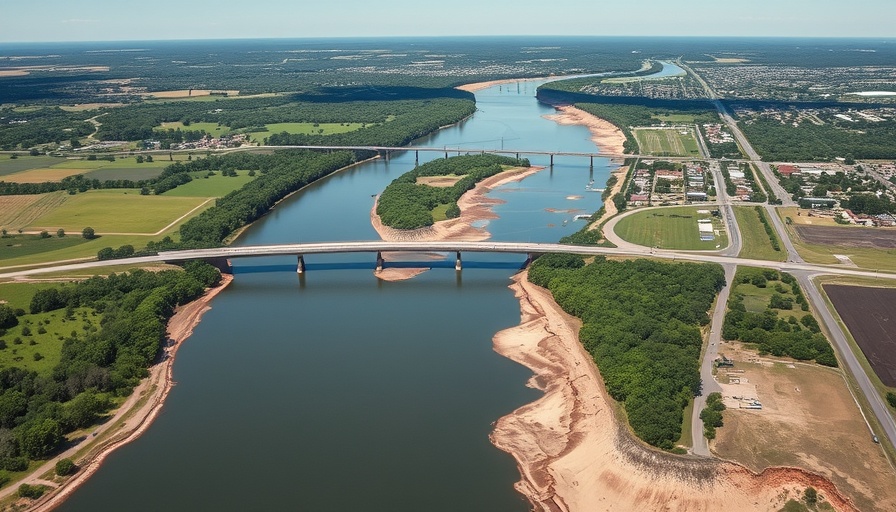
Understanding Texas's Flood Deaths: A Land of Extremes
Texas has once again been thrust into the national spotlight—not for its size, economy, or rich culture, but for a tragic reason: it leads the United States in flood-related deaths. A century of data reveals that floods have killed over 1,000 residents in the state from 1959 to 2019, which amounts to nearly one-fifth of all flood fatalities in the continental United States. In a year that has seen devastating floods across various regions, including a particularly deadly incident in San Antonio, understanding the underlying causes of these high numbers is essential for both local and national stakeholders.
Geography's Role: A Double-Edged Sword
The unique geography of Texas is central to the problem. Situated near the Gulf of Mexico, it has a diverse landscape characterized by hills, valleys, and large expanses of flat terrain. This terrain can funnel rainwater into specific areas, leading to flash floods. The same features that make Texas beautiful also pose significant risks—particularly during storms that produce torrential rain. For instance, in 2024 alone, flooding became the second leading cause of weather-related deaths in the nation, second only to heat. It is not merely the occurrence of rain that causes danger; rather, it is how it interacts with Texas's landscape that creates life-threatening situations.
How Human Behavior Contributes to Flood Fatalities
Data shows that 86% of flood deaths in the U.S. involve individuals entering floodwaters, mostly while driving their cars. It’s a sobering reality that often, people underestimate the force and danger of floodwaters—believing they can safely make it through submerged roads, a decision which has proven fatal time and again. This pattern highlights the critical need for effective public education and behavioral change to lower accident rates during floods.
The Need for Enhanced Emergency Systems
Amid escalating flood fatalities, experts like Dr. Hatim Sharif from the University of Texas at San Antonio emphasize the necessity for better emergency response systems. These systems should utilize advanced flood forecasts and real-time data to create integrated warning systems tailored to vulnerable areas. For example, developing a system that informs residents of imminent flooding and closures can significantly mitigate risk. “If they had an integrated warning system that uses rainfall forecasts… that could have saved many lives,” Sharif argues, underscoring the importance of proactive measures ahead of natural disasters.
Local and Global Perspectives on Flood Management
Taking a broader view, the challenges Texas faces with flood management are reflected in many regions around the globe. Countries prone to seasonal monsoons and heavy rainfall have similarly adopted advanced forecasting and public alert systems. Incorporating lessons learned from places like Bangladesh and the Netherlands, which have historic battlefronts against floods, may provide Texas with crucial insight into refining their flood management strategies. Each region’s unique circumstances demand customized solutions, but shared global experiences can foster innovations that benefit everyone.
Burden on Emergency Services and Community Implications
A recurring concern surrounding these natural disasters is the immense strain they place on emergency services and community resources. Floods lead to increased demand for rescue operations, medical responses, and recovery efforts, often taxing local budgets and resources. What’s more, the psychological toll on communities that frequently face the specter of flooding cannot be overstated. Post-traumatic stress and anxiety significantly affect both individual victims and responders alike, emphasizing the need for a well-coordinated, community-wide approach to flood preparedness.
Educational Initiatives: Turning Awareness into Action
Education plays a pivotal role in preventing flood-related deaths. Schools, local governments, and community organizations should collaborate to create educational programs focused on understanding flood risks, urging residents not to enter floodwaters, and informing them about local emergency procedures. Through workshops, simulations, and outreach efforts, communities can foster a culture of preparedness that increases resilience against future floods.
The Human Cost of Inaction: Understanding Emotional Impact
While statistics provide a stark view of flood fatalities, it’s vital to recognize the human aspect of these numbers. Each statistic represents a life lost—a parent, a child, a friend—each with their own story. As seen in the 2024 San Antonio floods, where 11 lives were extinguished by a moment’s bad decision, the emotional scars linger long after the waters have receded. Addressing these tragedies through awareness and responsive systems can not only save lives but help heal communities.
Taking Action Now: What Can You Do?
As residents of Texas confront these pressing challenges, it’s essential to take personal responsibility for understanding flood risks. Engaging proactively with local emergency services, staying informed about weather changes, and participating in community educational initiatives can help make a difference. Advocating for improved infrastructure and alert systems is also crucial as part of a grassroots movement towards greater public safety.
Conclusion: A Call to Collective Action
This summer, as Texas navigates its way through severe weather patterns, understanding and addressing the factors contributing to flood fatalities becomes an urgent priority. From the geographical challenges to the necessary improvements in emergency response systems, each element plays a role in creating a safer future. By promoting awareness and collaboration, we can bolster community resilience and ensure that tragic statistics become a thing of the past. Stay alert, stay informed, and take action, because the cost of inaction is simply too high.
 Add Element
Add Element  Add Row
Add Row 



 Add Row
Add Row  Add
Add 


Write A Comment